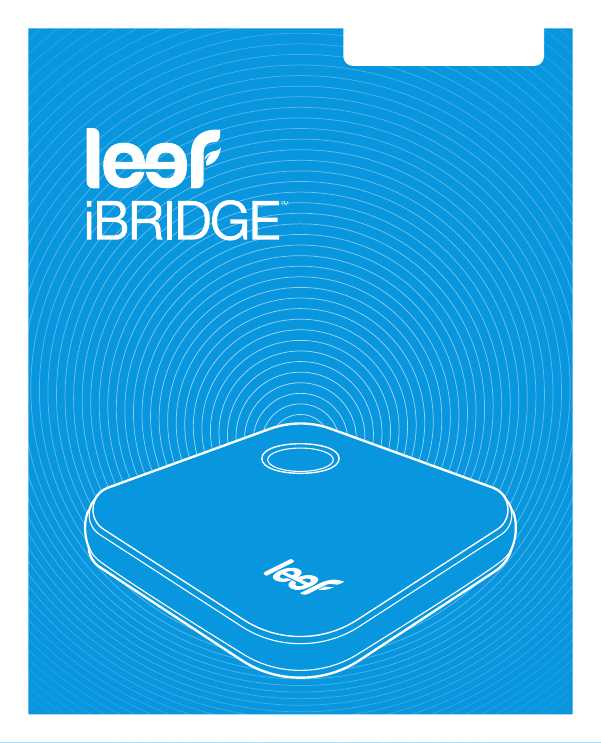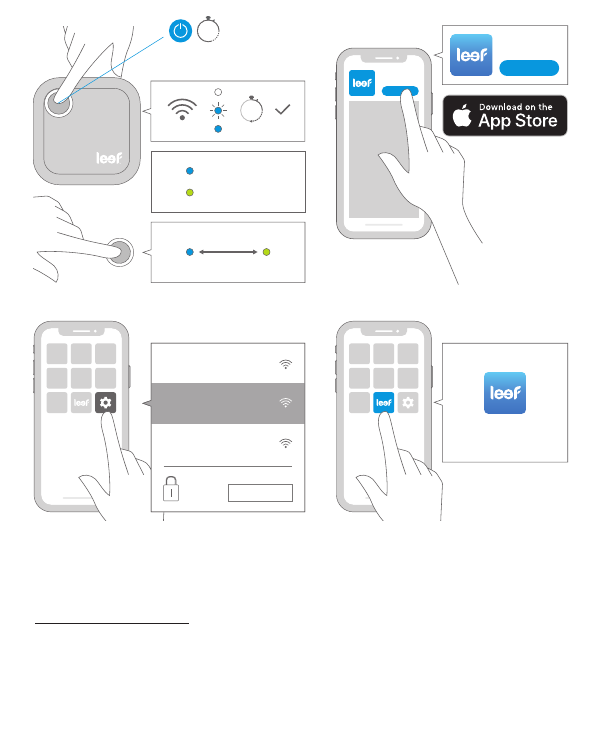Field and LIBA00 Leef iBridge Air User Manual Leef iBridgeAir Quick Start Guide stg5
Field and Company, LLC. Leef iBridge Air Leef iBridgeAir Quick Start Guide stg5
Users Manual

Air
Mobile Wireless Flash Drive
QUICK START GUIDE

5 GHz (default)
2.4 GHz
:20
3 4
iBridge Air App
GET
Welcome to iBridge Air!
Network 1
Network 2
Leef iBridge Air...
leef1234
Default
Password:
2x
This device complies with part 15 of the
FCC Rules. Operation is subject to the
following two conditions: (1) This device
may not cause harmful interference (2) This
device must accept any interference
received, including interference that may
cause undesired operation.
Note: This equipment has been tested and
found to comply with the limits for a Class B
www.leefco.com/iBridgeAir
NEED HELP?
services@leefco.com
Art No: QSG-A1-V3
digital device, pursuant to Part 15 of the
FCC Rules. These limits are designed to
provide reasonable protection against
harmful interference in a residential
installation. This equipment generates, uses
and can radiate radio frequency energy and,
if not installed and used in accordance with
the instructions, may cause harmful
interference to radio communications.
However, there is no guarantee that
interference will not occur in a particular
installation. If this equipment does cause
harmful interference to radio or television
reception, which can be determined by
turning the equipment off and on, the user is
encouraged to try to correct the interference
by one or more of the following measures:
Reorient or relocate the receiving antenna.
Increase the separation between the
equipment and receiver. Connect the
equipment into an outlet on a circuit
different from that to which the receiver is
connected. Consult the dealer or an
experienced radio/TV technician for help.
Warning: Changes or modifications to this
unit not expressly approved by the part
responsible for compliance could void the
user’s authority to operate the equipment.
The device has been evaluated to meet
general RF exposure requirement.
The device can be used in portable
exposure condition without restriction.
:02
1 2

This device complies with part 15 of the FCC Rules.
Operation is subject to the following two conditions:
(1) This device may not cause harmful interference.
(2) This device must accept any interference received,
including interference that may cause undesired
operation.
NOTE: This equipment has been tested and found to
comply with the limits for a Class B digital device,
pursuant to Part 15 of the FCC Rules. These limits are
designed to provide reasonable protection against
harmful interference in a residential installation. This
equipment generates, uses and can radiate radio
frequency energy and, if not installed and used in
accordance with the instructions, may cause harmful
interference to radio communications.
However, there is no guarantee that interference will
not occur in a particular installation.
If this equipment does cause harmful interference to
radio or television reception, which can be
determined by turning the equipment off and on, the
user is encouraged to try to correct the interference
by one or more of the following measures:
� Reorient or relocate the receiving antenna. Art No.: QSG-A1-V1f CAN ICES-3 (B)
� Increase the separation between the equipment
and receiver.
� Connect the equipment into an outlet on a circuit
different from that to which the receiver is
connected.
� Consult the dealer or an experienced radio/TV
technician for help.
WARNING: Changes or modifications to this unit not
expressly approved by the part responsible for
compliance could void the user’s authority to operate
the equipment.
The device has been evaluated to meet general RF
exposure requirement.
The device can be used in portable exposure
condition without restriction.
This device complies with Canada Industry
licence-exempt RSS standard(s). Operation is subject
to the following two conditions: (1) This device may
not cause interference. (2) This device must accept
any interference. Including interference that may
cause undesired operation of the device.

Cet appareil est conforme à la partie 15 des règles FCC.
L'opération est soumise aux deux conditions suivantes:
(1) Cet appareil ne peut pas causer d'interférences
nuisibles.
(2) Cet appareil doit accepter toute interférence reçue, y
compris les interférences susceptibles de provoquer un
fonctionnement indésirable.
REMARQUE: Cet équipement a été testé et déclaré
conforme aux limites d'un appareil numérique de classe
B, conformément à la partie 15 des règles de la FCC. Ces
limites sont conçues pour fournir une protection
raisonnable contre les interférences nuisibles dans une
installation résidentielle. Cet équipement génère, utilise et
peut émettre de l'énergie radiofréquence et, s'il n'est pas
installé et utilisé conformément aux instructions, peut
causer des interférences nuisibles aux communications
radio. Cependant, il n'y a aucune garantie que des
interférences ne se produiront pas dans une installation
particulière.
Si cet équipement cause des interférences nuisibles à la
réception radio ou télévision, ce qui peut être déterminé
en éteignant et en rallumant l'équipement, l'utilisateur est
encouragé à essayer de corriger l'interférence par une ou
plusieurs des mesures suivantes:
� Réorienter ou déplacer l'antenne de réception. Art No.: QSG-A1-V1f NMB-3 (B)
� Augmentez la distance entre l'équipement et le
récepteur.
� Connectez l'équipement à une prise sur un circuit
différent de celui auquel le récepteur est connecté.
� Consulter le revendeur ou un technicien radio / TV
expérimenté pour obtenir de l'aide.
AVERTISSEMENT: Les changements ou modifications
apportés à cette unité qui ne sont pas expressément
approuvés par la partie responsable de la conformité
peuvent annuler l'autorité de l'utilisateur à utiliser
l'équipement.
L'appareil a été évalué pour répondre aux exigences
générales d'exposition aux RF.
L'appareil peut être utilisé dans une condition
d'exposition portable sans restriction.
Le présent appareil est conforme aux CNR d’Industrie
Canada applicables aux appareils radio exempts de
licence. L’exploitation est autorisée aux deux conditions
suivantes :
(1) l’appareil ne doit pas produire de brouillage.
(2) l’utilisateur de l’appareil doit accepter tout brouillage
radioélectrique subi, même si le brouillage est
susceptible d’en compromettre le fonctionnement.